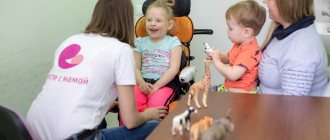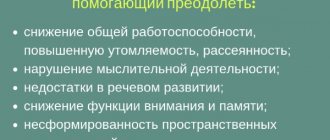Doctors Cost
Price list Doctors clinic
Speech therapy massage is a method of restoring normal speech function, which is widely used as part of an integrated approach. It allows you to speed up the process of correcting speech defects and get impressive results in a short time. There are no age restrictions for the use of such a massage; it can be recommended by a pediatrician or prescribed by a speech therapist. Massage is provided as part of an appointment with a speech therapist.
This method can effectively complement articulation, breathing exercises, and other methods of stimulating the development of normal speech.
Order of conduct
There are two types of speech therapy massage. The first involves working only with your fingers, the second involves the use of special tools. A doctor can prescribe one or another type of massage for certain indications.
The procedure includes a combination of techniques:
- respiratory correction;
- massaging the facial muscles;
- neck muscle massage;
- massaging speech structures (tongue, inner surface of cheeks, lips) using a probe.
Manual or manual massage consists of stroking, pinching, and rubbing. In some cases, the doctor uses auxiliary instruments - a pacifier, a spatula, a toothbrush. The specialist’s actions are aimed at kneading the muscles and improving the blood supply to the tissues. Manual massage also includes acupressure, in which the master influences reflex zones.
Children's speech therapy massage using a probe was developed by speech therapist E. V. Novikova. This technique involves influencing areas of the speech apparatus using 9 different types of probe. The choice of a specific tool takes into account the problem area, as well as the severity of the speech disorder. Different shaped probes are designed to produce different effects.
Actions for increased and decreased muscle tone
Speech therapy massage for low muscle tone begins with light massaging movements of the shoulder girdle. After this, the specialist touches those articulatory areas that are least active in the child. For example, movement disorders can occur when the chewing muscles or cheekbone muscles are underdeveloped. In this case, this area needs to be particularly actively affected.
The force of pressure should increase gradually, with each session, and the pressure, despite its intensity, should not cause pain in the patient.
For hypertension, a massage with a relaxing effect is prescribed. All movements are made in the direction from the periphery to the central part, and the pressure force should be small, otherwise the condition of the articulatory apparatus may deteriorate. The movements should be sliding and slightly pressing. Each movement should be repeated approximately 8 times. The pace of the massage is slow (it is the slow pace that reduces the degree of tissue excitability). Simultaneously with the impact on muscle tissue, the specialist asks the child to perform passive head movements. This means that the patient must slowly turn their head clockwise and then counterclockwise. Thanks to this technique, it is possible to relax the neck muscles, which helps reduce the increased tone of the tongue.
During various techniques, not only massage of the tongue muscles is performed. The doctor makes stroking movements (longitudinal and transverse) in the area of the forehead and bridge of the nose, presses on the hair growth area, and makes tapping movements in the area of the lip muscles to completely relax them.
Please note: some children are diagnosed with increased and decreased tone of various muscles. In this case, a differentiated massage is carried out: the specialist acts on some parts more actively, while others massage with relaxing movements. This approach requires high qualifications and a lot of practice.
Results of speech therapy massage
The method allows you to change the condition of muscles, nerve fibers, and blood vessels of the speech apparatus. This technique makes it possible to speed up the process of normalizing pronunciation, as well as the emotional state of children with speech defects. Massage can have a beneficial effect on tissues, improve the secretory function of the skin and activate blood and lymph flow. This leads to improved metabolic processes and oxygen supply to tissues.
The rhythmic movements of a specialist accelerate the outflow of venous blood, the function of lymphatic vessels improves, the structure of the muscular system changes (the elasticity of muscle fibers, contraction strength, and performance increase). The use of various techniques makes it possible to reduce the tone of spastic muscles and increase it with flaccid paresis.
Thus, speech therapy massage allows you to obtain the following effects:
- normalization of muscle tone, muscle contraction processes;
- stimulation of the muscles responsible for producing certain sounds;
- stimulation of blood circulation, acceleration of nerve impulses;
- relief of spasm;
- assistance in the child’s understanding of the controlled and uncontrolled areas of the speech apparatus and their management;
- decreased salivation caused by diseases of the nervous system;
- strengthening the pharyngeal reflex;
- facilitating the process of correcting sound pronunciation.
A speech therapy massage specialist will conduct a session as part of your appointment, and will also tell you how you can consolidate the results at home. He will explain some techniques so that you can independently stimulate the development of your child’s speech apparatus.
Conditions for speech therapy tongue massage
The doctor's office should be warm and comfortable enough. The specialist’s hands must be warm and immaculately clean, and his nails must be cut short. The optimal time for massage is two hours after eating. Before the procedure, the child’s mouth must be thoroughly cleaned.
The approximate number of sessions is 20. The exact number is determined by the speech therapist, depending on the severity of the speech defect. To achieve maximum effect, the procedure is carried out every day. The duration of the session varies from 5 to 25 minutes, depending on the severity of the disorder.
Before starting the session, it is important for the patient to take the correct and most comfortable position. Here are the most optimal positions for the procedure.
- ✪ The child lies on his back, a special cushion or small pillow is placed under his neck. In this case, the head should be fixed and slightly tilted back.
- ✪ There is another option - the child simply sits in a chair that has a high headrest (this is a great way for those children who feel nervous when asked to lie down on the couch).
- ✪ During speech therapy massage, small children can be in a stroller in a half-sitting position, while their head should also be slightly tilted back.
- ✪ If a child is very afraid of various medical procedures, you can sit him on the parent’s lap.
During the massage, the patient must be in a calm state; pain and discomfort are not allowed. If a small patient is not in the mood for the procedure, in the first session you can limit yourself to light massaging movements in the facial area. It is acceptable to conduct sessions in the presence of parents if the child feels more relaxed when loved ones are nearby.
Immediately after the procedure, it is recommended to provide the child with complete rest for 15-20 minutes, after which he can go home and go about his daily activities. It is worth noting that even with the help of the most professional massage you cannot achieve an instant effect: the first results can only be noticed after a few weeks.
Contraindicated for whom
Massage is contraindicated for the following diseases:
- acute inflammatory processes in the oral cavity: viral diseases (herpes), rash caused by bacterial infection, gingivitis, etc.;
- enlargement of the submandibular lymph nodes;
- acute infectious disease;
- high body temperature;
- symptomatic epilepsy;
- intracranial hypertension.
Also, speech therapy massage is impossible in cases where the child, due to age or mental state, is unable to listen to the doctor, has a negative attitude towards his actions, and cannot sit still.
Advantages of visiting the Family Doctor clinic
The advantage of speech therapy massage as part of a specialist appointment is its affordable price, which makes this procedure in demand in many cases of speech defects. We offer our patients quality care.
- Comprehensive diagnostics: accurate assessment of the state of the muscles of the speech apparatus, determination of the general state of health, speech disorders, etc.
- Team approach: combining advanced techniques and correction techniques to achieve the desired result.
- Professionalism of doctors: consultations are conducted by specialists with many years of experience.
To make an appointment at a time convenient for you, call the single contact center in Moscow, fill out the online appointment form or contact the clinic reception.
leave feedback
The use of innovative equipment in speech therapy work with children
Cherchenko Zoya Mikhailovna
The use of innovative equipment in speech therapy work with children
Specific features of impaired sound pronunciation in dysarthria are the persistence of defects and the difficulty of overcoming them, as well as the need for a longer period of automation of sounds. Children with dysarthria often suffer from attention deficit and hyperactivity, they are difficult to captivate with anything, they get tired quickly, etc.
As a rule, parents do not carry out drug treatment prescribed by neurologists or physiotherapeutic procedures.
In this regard, the correction process has a long and complex dynamics.
There is a need for more active medical and pedagogical influence using “bypass”
auxiliary means to achieve an effect in eliminating dysarthric manifestations.
To interest children and make learning meaningful, we need non-standard approaches, individual development programs, and new innovative technologies . Against the backdrop of comprehensive speech therapy assistance, innovative technologies , without requiring much effort, optimize the process of correcting children’s speech and contribute to the healing of the entire body.
I would like to present to your attention a new speech therapy instrument, the speech therapy electric massager Z-Vibe, which is an innovation that integrates general speech therapy massage and high-frequency electromagnetic vibrations.
The device consists of an aluminum case, which contains a micromotor-vibrator, a battery, and a replaceable threaded tip.
The tips change depending on the need for impact (relaxation - stimulation)
.
Additional tips are sold separately.
A speech therapy massager has a diameter no larger than a ballpoint pen. Replaceable vibrating massager attachments are made of food-grade plastic, do not contain harmful dyes and can withstand sterilization with UV lamps.
Made in USA
The principle of operation of Z-Vibe is to influence the tongue, inner and outer surfaces of the cheeks, forehead, chin with high-frequency vibrations. As a result of these vibrations, muscle tone relaxes or increases, depending on the attachments used . The transfer of small, fast, alternating oscillatory movements to the tissues causes strong contraction of the muscles and gives them greater elasticity, improves tissue trophism. The purpose of the massage is to normalize speech motor skills.
The method of speech therapy involves performing basic standard massage movements. The main universal attachment of the massager has two different surfaces: lumpy and striated. Used for cheeks , lips, tongue, gums, palate.
The cross-striped side is aimed at normalizing the muscles of the art. device for hypertonicity;
The lumpy side is aimed at normalizing the muscles of the art. device for hypotension.
Attachment for speech therapy massager Z-Vibe for massaging the hollow of the tongue
This attachment is designed for speech therapy vibration massager; it allows you to quickly create and prepare a “groove” in the child’s tongue for subsequent production of sounds.
It is also used for speech therapy massage , in places where the accuracy of the speech therapist’s .
Ribbed attachment for speech therapy massager Z-Vibe .
This attachment is used both for external speech therapy massage of lips , cheeks, etc., and for massage of the child’s articulation apparatus.
In addition, the massager helps to very effectively stretch the frenulum, support the tongue, and massage the hollow of the tongue to help produce whistling sounds. Also, it is very effective in producing vibration of the tip of the tongue when making the sound “R”
.
For this purpose, “artificial starting of the motor”
is used Experience with dysarthria confirms that the use of the Z-Vibe electric massager optimizes work the organic manifestations of dysarthria. In addition, as studies indicate, the massager has proven itself very well in working with children with hearing impairments .
Device for monitoring your own speech
This device is used during classes with a speech therapist to develop phonemic hearing and independent control of speech in a child.
During classes with a speech therapist , the child holds the device like a telephone handset and pronounces phrases.
The whole effect is that the child hears himself without distortion through the “inner hearing of a person” and is able to correct speech depending on what he hears.
The device uses only mechanical principles of sound transmission.
Specialized computer technology for correcting general speech underdevelopment “Games for Tigers”
Designed to correct general speech underdevelopment in children of older preschool age.
Program "Games for Tigers"
offers more than 50 exercises with several levels of difficulty, combined into four thematic blocks:
— "Prosody"
,
— "Sound Pronunciation"
,
— "Phonematics"
,
— "Vocabulary"
.
Work with all exercises in the program is carried out based on visual control over the results of the child’s activities. They are visualized on the monitor screen in the form of cartoon images and symbols. In some exercises that cause difficulties, the possibility of additional auditory support is provided when performing the task.
On the computer side, it is not an impersonal program, but a cheerful and amusing computer hero, Tiger Cub, who explains to the child the purpose and rules for completing the proposed task, helps to complete it, and gives a final or intermediate assessment of the action performed.
Program "Games for Tigers"
easy to operate. It has an accessible interface with tooltips.
Block "Prosodika"
.
operating principle of this unit is based on interactive communication between a child and a computer using a microphone . In this case, speech activity is recorded by a microphone and presented on the computer screen in the form of visual animations.
Selection of exercises included in the “Prosody”
, is made from a submenu that includes four modules.
Module "Breathing"
.
The exercises in this module allow you to practice smooth, long or short, sharp exhalation, track the moment speech activity starts, and also measure the strength and duration of speech exhalation and voice (in relative units and in seconds, respectively)
.
Module "Confluence"
.
The exercises in this module allow you to work on the clarity and intelligibility of a child’s speech based on phrases, the strength and duration of exhalation and voice based on speech exhalation without phonation, with phonation - based on vowels and consonants, and practice the continuous pronunciation of sounds, syllables , words and phrases.
Module "Rhythm"
.
Exercises of the module "Rhythm"
allow you
to work on the rhythmic and syllabic structure of the word , as well as on the clarity and intelligibility of the child’s speech.
Module “Pitch and Timbre”
.
In this module, the computer speech therapy program “Games for Tigers”
allows you to visually record and measure the frequency characteristics of speech for the purpose of further correction in the exercises of this module, as well as select an acceptable timbre range of speech in a child with phonation disorders.
The exercises in this module also allow you to build vocal tasks for the development of the child’s vocal apparatus. This is facilitated by working on speech exhalation , height and duration of the voice.
Work on the exercises of this module is based on individual sounds, their complexes, syllables , words, phrases.
Block “Sound Pronunciation”
.
Working with exercises in the “Sound Pronunciation”
allows you to develop the efferent
(development of motor properties of the organs of articulation)
and afferent motor part of the speech system.
Block "Phonematics"
.
Sounds module
.
Exercises from the Sounds
allow you
to work on the development of phonemic hearing using the material of non-speech sounds, speech sounds and sound complexes.
Module "Words"
.
Exercises of the module "Words"
can
be used for the development of phonemic hearing based on words, correction of sound pronunciation at the stage of automation and differentiation of defective sounds, as well as for the development of the child’s vocabulary and thinking.
"Analysis" module
.
Exercises in the Analysis
allow you to organize
work on the formation of phonemic perception in children, correction of sound pronunciation at the stage of automation of defective sounds.
Module "Synthesis"
.
Exercises of the module "Synthesis"
allow you
to work on the formation of phonemic synthesis in children.
Block "Vocabulary"
.
This block is aimed at correcting lexico-grammatical speech disorders in children. The block includes three modules. Exercises within each module allow you to organize correctional work in a specific direction.
When working with the exercises of this block, children’s vocabulary is formed on the main topics: “Clothing”
,
“Shoes”
,
“Furniture”
,
“Utensils”
,
“Tools”,
etc., the concept and meaning of generalizing words is formed.



